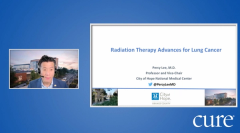
Educated Patient® Lung Cancer Summit Basics of Lung Cancer Panel: April 29, 2023
Watch Dr. Thomas Waddington and Dr. Percy Lee answer questions about diagnostic and radiation advances during the CURE® Educated Patient® Lung Cancer Summit.
Episodes in this series

This panel was moderated by Darlene Dobkowski, and included Dr. Thomas Waddington and Dr. Percy Lee.
Dobkowski: Are these photodynamic and pulsed electric fields for a certain type of lung cancer and are these in trial stage only at this time?
Waddington: The photodynamic therapy works much better for tumors that are growing very quickly. Tumors that are growing very slowly (carcinoid tumors, lipidic type tumors) don't take up the drug. So if you look at the photoferon, it's got to be taken into the tumor itself, because 48 hours later, I've got to be sitting there ablating. And if it's not sitting there, we just don't get the concentration.
The pulsed electric field is very different, because we don't understand how effective it will be in non-immune related tumors. So if you look at the tumors that have a lot of immune-related cancer cells, in other words, some tumors don't activate the immune system very well, and others really activate the immune system. Right now, the pulsed electric field seems to work much better in the tumors that activate the immune system. There's a neat study that's been done for breast cancer with triple -negative breast cancer. And in this study, they introduced tumor cells into an animal model. They did post electric field, they use one of these drugs, Dr. Lee talked about a checkpoint inhibitor. And then they introduced tumors into the other part of the animals with the same type of tumor. And when they did this, they actually found that because the immune system had been activated, there was this system, this was part of the immune response that actually attacked the other tumors that had never been treated before.
So I wish I had a simple answer. Slow growing tumors definitely don't work for photodynamic therapy, and the pulsed electric field right now I can tell the need there is immunotherapy is working well, the immune the tumors that have high immunogenetic component to it are going to work very well. The other ones I'm not sure about yet, honestly.
Dobkowski: Thank you, Dr. Waddington. And our next question is if a patient has a high disease burden in the lungs, and metastasizes to the bones and or the brain, is it safe to do SBRT or SRS treatment of bone or brain metastases simultaneously with a tyrosine kinase inhibitor therapy?
Lee: Yeah, that's a great question. I think, given that the targeted therapy has been so effective in various targets, the molecularly driven cancers, our general approach is to do the targeted therapy for a number of weeks, often at least 12 weeks. And in that situation, if a patient afterwards has limited sites of brain or bone metastasis, we can then use SBRT. Since it's so short of a course, we often will pause the targeted therapy during the radiation. Now, it can be delivered, but we just think it's safer to do the high dose radiation while off the TKI. And so that approach has been studied, currently ongoing studies looking at that both for oligometastatic or what's called poly metastatic where patients could have high disease burden in studies. One called the North Star study from MD Anderson where I participated in to see if using a targeted therapy for 12 weeks, and then targeted radiation improves the patient's outcome versus just targeted therapy through their course of treatment.
Dobkowski: So with that tactic, is there an increased risk for toxicity? And then also, can WBRT or whole brain radiation therapy be combined with a TKI?
Lee: So far, studies have shown that this approach of combining treatment is quite safe. There's even studies of using the TKI concurrent with the radiation in the lung. Where the concern was with radiation pneumonitis and that hasn't been seen to increase with a combination. The other question was, can TKI be combined with whole brain radiation? I think, for the most part, we tend to also hold the TKI while we give radiation. The radiation operation is often two weeks or less. After two weeks, and I think in general, it's just safer to hold systemic therapy while we deliver radiation mainly to make sure that we don't cause additional detriment to patients’ quality of life cognitive function down the line.
Dobkowski: And can you do SBRT to the left upper lobe of a person who has a pacemaker or defibrillator?
Lee: That's a great question. We often quiz our trainees that are bored with something like that. So the answer is yes, oftentimes, because the dose drops out really quickly, what we do is we have a patient being evaluated by their cardiologist to terminate their pacer dependent or not. When we do the planning, we can determine how much radiation is actually going to the pacemaker. And as long as we keep it under very low amount of gray, it should have no impact. Sometimes if the patient's pacemaker dependent, we’ll do additional things like having on site monitoring by a cardiologist, and then having the pacemaker checked. If it's worse, and I've never actually had to do this, we can actually move the pacemaker before the radiation, and that's only if the tumor is really behind the pacemaker. And there's no other choice.
Dobkowski: Definitely interesting. So are there any studies on SBRT following only with immunotherapy and no chemotherapy?
Lee: Yes, actually, that's quite interesting. So there are a number of studies.In early stage lung cancer, for example, we just published a small phase 2 study of SBRT for early stage lung cancer, followed by Imfinzi. or durvalumab. And basically, the idea is that can we use the combination to prevent radiation splitting, which works really well, killing the tumor that we see, but patients can have recurrences elsewhere. And so we're hoping that the immunotherapy can eradicate any microscopic cancer that may be around. It was an early safety study that showed that it was reasonable to combine but now there are ongoing phase 3 studies, at least three or four of them internationally looking at this question. And I think one is going to be read out very soon and actually, preliminary, I've heard that the outcomes are probably better, but we have to wait till the long-term outcomes of a combination. So I think that's in the future for stage 1, and perhaps the question was, can it be used without chemo? So there's other studies like that for stage 3. When patients have high what's called high PD-L1, where their tumor makeup shows a lot of PD-L1, which is the marker for response to immunotherapy. There are studies to see if we can omit chemotherapy during radiation and afterwards with just radiation and checkpoint inhibitor.
Dobkowski: Thank you. Dr. Waddington, obviously, you're talking about the future of what we can expect in this area. How soon do you think that future will come?
Waddington: So far, as far as photodynamic therapy and pulsed electric field, they're here. We're actively doing trials at City of Hope with pulsed electric field technology where we've had incredible success in liver (cancer), where we especially, with Dr. Lee was talking about, had a head and neck cancer witha high PD-L1, they were having progression of disease. And my colleague, Dr. Kessler, brought the patient into the interventional radiology suite gave him post electric field. And literally in two months as this cancer was moving past treatment, it's regressed over 50%. It's just been an amazing response.
Pulsed electric field is here. Photodynamic therapy is in the airway itself, it has been here for quite a long period of time, what we're trying to do is see what can actually be used in the lung. That's always been a driving point. But it's been very difficult up till now, because we didn't have these robotic systems that could get us in the right spot. If you're going to be using a device to activate it, you need to make sure the device is within the tumor. And we couldn't guarantee that in the past. So these studies are all moving forward as we're actually talking. One of the real things I love about what Dr. Lee's doing and about what the immunotherapy is actually doing and how that pulsed electric field is really trying to do. And in photodynamic is we have this Gopal effect where all these treatments that we're doing is what if you know Dr. Lee's hitting this tumor? He's completely destroying it but there's a cancer cells somewhere else. Well, radiation therapy as well was pulsed electric field and other thermal-related techniques are now starting to show maybe you're actually not just treating the tumor, you're actually treating the cancer cells that have escaped. And so that's being looked at a lot as well.
Dobkowski: That's important. So if a patient has underwent SBRT in the past, can they have it again if needed?
Lee: Yeah, actually, a lot of our patients today have multiple courses of SBRT. Typically, it's more challenging if we're trying to retreat at the same area, but oftentimes patients have control of the disease and they have another lung lesion or other bone lesions. I can think of one patient, beginning my career at UCLA with this, just before targeted therapy, Tarceva (erlotinib) was invented. And she lived 12 years and had like, at least 15 courses of SBRT during the time with TKIs and newer TKIs.
And so the answer is yes. And even if the patient had prior radiation to the same area, sometimes we could do that. But we prefer to use the techniques like what Dr. Waddington has talked about, like thermal ablation or your techniques, because we don't want to unnecessarily try the same thing again, if there's other options available.
Dobkowski: Can sbrt be used on metastases to lymph nodes?
Lee: Yes, we do that also very frequently, either in the abdomen or even in the lung. Now we have to be a little cautious. There is this concept of central tumors where if a tumor is within 2 centimeters of certain structures like airway, large airways or esophagus, we know that there's more toxicity with high-dose SBRT. The way to get around that is using a lower dose. Or sometimes, even though SBRT is five or fewer treatments, we can also extend that treatment to 10 treatments and give a moderate dose, maybe technically not called SBRT. But we use similar approach to SBRT just delivering a safer manner. And then with things like MRI-guided radiation, now we could see better, it's a way we could treat lymph nodes and are essentially tumors while sparing healthy tissue.
Dobkowski: Alright, so we have time for one more. What is the prognosis for SRS treatment? What do you think of the prognosis score for predicting survival in patients treated with robotic stereotactic radiotherapy for brain metastases?
Lee: Yeah, that's a good question. But it's difficult to answer, really depends on context of how many brain metastases and what's the extent of their cancer elsewhere? What are the remaining options for systemic therapy? I would say if the patient had molecularly-driven cancers, we often think that the prognosis is actually quite good. And sometimes we even omit radiation, whole brain radiation or even SRS in those situations, because we know that the TKI can essentially eradicate some of these lesions, and we reserve the SRS to resistant clones of cells. So I think my long way of saying the answer is really depends on the clinical context and sort of overall “How's the patient doing?” and certainly SRS is relatively low toxicity. And now we're treating more and more lesions. In the past was like three or four lesions, five, maybe. We can use SRS for many more lesions now. And we try to avoid whole brain radiation when possible.
Transcription edited for clarity.
For more news on cancer updates, research and education, don’t forget to















